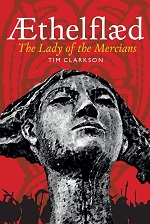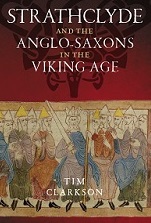The Strathclyde Britons or Cumbri had their own particular style of stonecarving which was influenced by other styles such as Pictish, Irish and Anglo-Saxon. The royal/ecclesiastical settlement at Govan appears to have been the centre from which this distinctive style was disseminated across the kingdom.
In this blogpost I’ve selected a number of images showing how the sculptors of the ‘Govan School’ transferred their ideas to one type of monument: the free-standing cross.
—–

1. The Jordanhill Cross Only the broken shaft of this monument now survives. It can be seen inside Govan Old Parish Church. The image above shows a 1930s reconstruction near the edge of the churchyard.
—–

2. The Barochan Cross Formerly located on a hill near Houston in Renfrewshire, it is now kept inside Paisley Abbey. The illustration here is from John Stuart’s Sculptured Stones of Scotland (1856-7).
—–

3. The Arthurlie Cross The surviving part of the cross-shaft can be seen at a road junction in Barrhead, East Renfrewshire.
—–

4. The Dumb Proctor Re-shaped in modern times and placed on a family grave, this monument stands in a cemetery at Lochwinnoch, Renfrewshire. The image on the right shows how it might look today, if it hadn’t been altered (reconstruction by me, based on a drawing by Alan Macquarrie in the booklet cited below).
—–

5. The Kilwinning Cross The photograph shows one of the two surviving pieces of the cross-shaft at the North Ayrshire Heritage Centre in Saltcoats. The cross originally stood 4 miles away near Kilwinning Abbey.
—–

6. The Netherton Cross This intact monument once stood near the River Clyde, not far from Hamilton Services on the M74 motorway. It now stands beside the new parish church in Hamilton town centre.
—–
For further information on these crosses (and a couple of others not mentioned here) I recommend Alan Macquarrie’s Crosses and Upright Monuments in Strathclyde, the text of his Govan Lecture, published by the Friends of Govan Old in 2006.

* * * * * * *





Pingback: Strathclyde crosses | Heart of the Kingdom
How fascinating! I now want to jump in the car and go see them all! I will put that book on my list, too.
LikeLike
If you make the trip before the end of October, you might find it on sale at Govan Old. This year the church’s opening hours have been extended by a month.
LikeLiked by 1 person
Were there any of these fine crosses anywhere near the Anglo-Saxon Ruthwell cross? I mean, I suppose, are there any from the country south of the watersheds between Clyde/Annan or Clyde/Nith?
LikeLike
The most southerly ones are Kilwinning on the west and Netherton on the east. These seem to mark the southern limit of the Govan sculptural style and may thus mark the southern frontier of the heartlands of Strathclyde. Further south, as we approach Upper Clydesdale, we find sculpture in Anglo-Saxon (Northumbrian) style such as the cross-head from Lesmahagow. This style is similar to the Viking Age sculpture of Galloway, characterised by the crosses of the Whithorn School, although none of it is carved to the high standard seen on the 7th/8th century crosses at Ruthwell and Bewcastle.
LikeLike
Ta.
LikeLike
Apart from the absence of Pictish symbols (whch I suppose would have been out of use by this time anyway, how do these crosses differ from free standing Pictish crosses like the Dupplin Cross?
Certainly the figures, both on foot and mounted, look (to my untutored eye) very like the figures you get on Pictish crosses.
LikeLike
The Dupplin Cross is a useful one to highlight, because it is part of the same tradition of free-standing crosses. All were set up as statements of power and prestige by local elites. The main difference is stylistic and technical, i.e. the Dupplin carvings represent a high point of sculptural art, whereas those on the Strathclyde monuments represent a decline. The fading craftsmanship went right across the board and can be seen in Anglo-Saxon sculpture too, e.g. by comparing the finely detailed 8th-century cross at Ruthwell with the rougher 10th-century examples from Whithorn. The decline seems to begin c.850, which is when the Strathclyde sculpture with its chunky (and sometimes clumsy) interlace patterns first appears. By then, the Picts were producing similarly lazy stuff such as the Dunblane cross-slab.
You’re right about the Strathclyde figures looking like the ones we see on Pictish stones. It’s more than coincidence – the craftsmen of the Govan School borrowed many of their ideas from the Picts (and also from the Irish and Anglo-Saxons). This is why the stones inside Govan church are sometimes tagged as ‘Pictish’ when visitors upload photos on Flickr, etc. I’ve always thought the horseman on the Govan Sarcophagus looks like he’s ridden down from Perthshire.
LikeLike